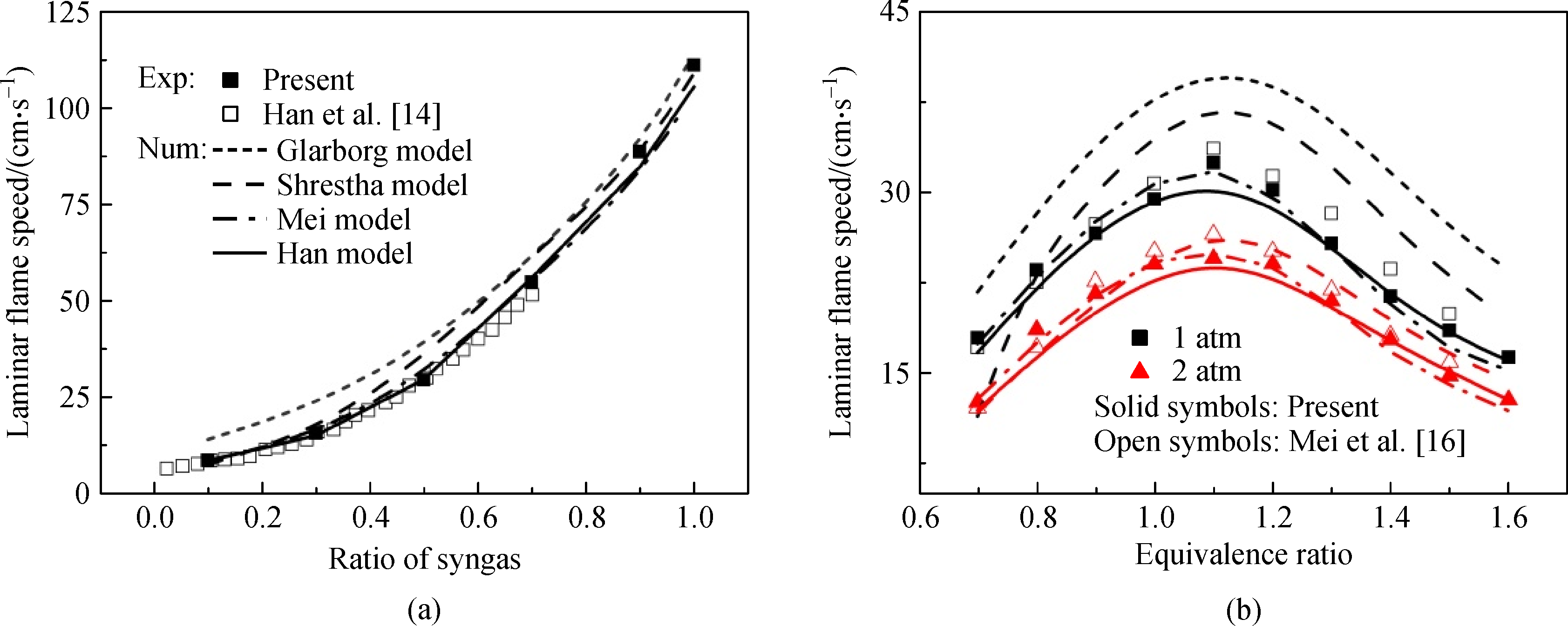

Experimental and kinetic study on laminar flame speeds of ammonia/syngas/air at a high temperature and elevated pressure
Received date: 07 Apr 2021
Accepted date: 25 Jun 2021
Published date: 15 Apr 2022
Copyright
The laminar flame speeds of ammonia mixed with syngas at a high pressure, temperature, and different syngas ratios were measured. The data obtained were fitted at different pressures, temperatures, syngas ratios, and equivalence ratios. Four kinetic models (the Glarborg model, Shrestha model, Mei model, and Han model) were compared and validated with experimental data. Pathway, sensitivity and radical pool analysis are conducted to find out the deep kinetic insight on ammonia oxidation and NO formation. The pathway analysis shows that H abstraction reactions and NHi combination reactions play important roles in ammonia oxidation. NO formation is closely related to H, OH, the O radical produced, and formation reactions. NO is mainly formed from reaction, HNO+ H= NO+ H2. Furthermore, both ammonia oxidation and NO formation are sensitive to small radical reactions and ammonia related reactions.

Geyuan YIN , Chaojun WANG , Meng ZHOU , Yajie ZHOU , Erjiang HU , Zuohua HUANG . Experimental and kinetic study on laminar flame speeds of ammonia/syngas/air at a high temperature and elevated pressure[J]. Frontiers in Energy, 2022 , 16(2) : 263 -276 . DOI: 10.1007/s11708-021-0791-7
| 1 |
Valera-Medina A, Morris S, Runyon J,
|
| 2 |
Balestri M, Cecchini D, Cinti V. Unconventional fuels experimental campaigns in gas turbine combustor at ENEL Sesta facility. In: Proceedings of ASME Turbo Expo 2004: Power for Land, Sea, and Air, Vienna, Austria, 2008: 121–128
|
| 3 |
Kurata O, Iki N, Matsunuma T,
|
| 4 |
Iki N, Kurata O, Matsunuma T,
|
| 5 |
Mei B, Zhang X, Ma S,
|
| 6 |
Xiao H, Valera-Medina A, Bowen P J. Study on premixed combustion characteristics of co-firing ammonia/methane fuels. Energy, 2017, 140: 125–135
|
| 7 |
Xiao H, Howard M, Valera-Medina A,
|
| 8 |
Wiseman S, Rieth M, Gruber A,
|
| 9 |
Issayev G, Giri B R, Elbaz A M,
|
| 10 |
Zhao Y, Xie Y, Wang X,
|
| 11 |
Whitty K J, Zhang H R, Eddings E G. Emissions from syngas combustion. Combustion Science and Technology, 2008, 180(6): 1117–1136
|
| 12 |
Rota R, Antos D, Zanoelo E F,
|
| 13 |
Hayakawa A, Goto T, Mimoto R,
|
| 14 |
Han X, Wang Z, He Y,
|
| 15 |
Wang S, Wang Z, Elbaz A M,
|
| 16 |
Mei B, Ma S, Zhang Y,
|
| 17 |
The Combustion Research Group at UC San Diego. Chemical-kinetic mechanisms for combustion applications. University of California at San Diego, 2014, available at the website of
|
| 18 |
Okafor E C, Naito Y, Colson S,
|
| 19 |
Zhang Y, Mathieu O, Petersen E L,
|
| 20 |
Shrestha K P, Seidel L, Zeuch T,
|
| 21 |
Han X, Wang Z, Costa M,
|
| 22 |
Glarborg P, Miller J A, Ruscic B,
|
| 23 |
Shrestha K P, Lhuillier C, Barbosa A A,
|
| 24 |
Yin G, Hu E, Huang S,
|
| 25 |
Yin G, Gao Q, Hu E,
|
| 26 |
Hu E, Yin G, Ku J,
|
| 27 |
Kelley A P, Liu W, Xin Y X,
|
| 28 |
Kee R J, Grcar J F, Smooke M D,
|
| 29 |
Yin G, Xu J, Hu E,
|
| 30 |
Manton J, Elbe G V, Lewis B. Burning-velocity measurements in a spherical vessel with central ignition. In: Symposium (International) on Combustion, 1953, 4(1): 358–363
|
| 31 |
Markstein G H. Nonsteady Flame Propagation. Oxford: Pergamon Press, 1964
|
| 32 |
Varea E, Modica V, Renou B,
|
| 33 |
Bian J, Vandooren J, Tiggelen P J V. Experimental study of the structure of an ammonia-oxygen flame. Symposium (International) on Combustion, 1988, 21(1): 953–963
|
/
| 〈 |
|
〉 |